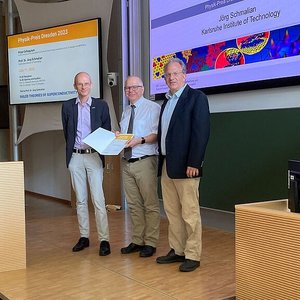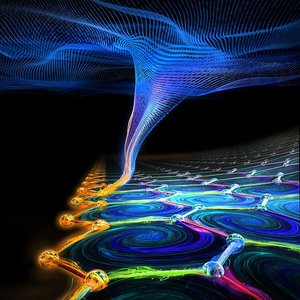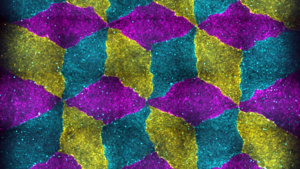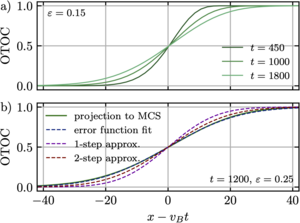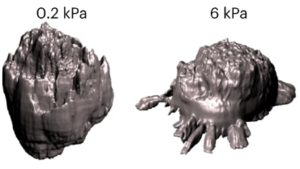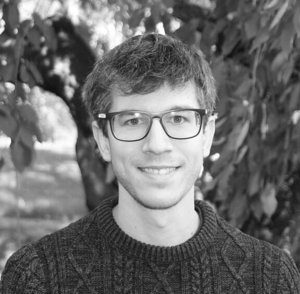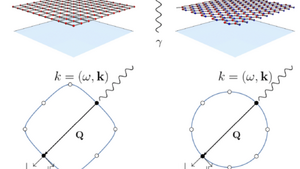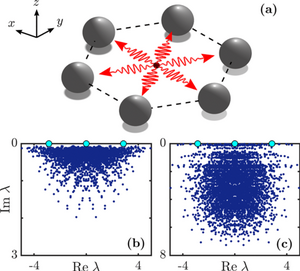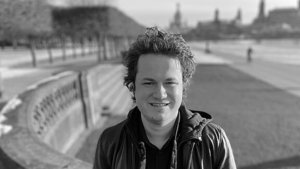
Highlights
Awards and Honors
"Physik-Preis Dresden 2023" awarded to Professor Jörg Schmalian
On July 11, 2023, Prof. Jörg Schmalian from the Karlsruhe Institute of Technology received the "Physik-Preis Dresden 2023" (Dresden Physics Prize), jointly awarded by the TU Dresden and the Max Planck Institute for the Physics of Complex Systems (MPI-PKS).
The "Physik-Preis Dresden" has been established, with a generous donation by Prof. Peter Fulde, to promote cooperation between the Max Planck Institute for the Physics of Complex Systems and the Faculty of Physics of TU Dresden. It is geared towards outstanding researchers whose research is of particular interest to scientists in Dresden. This year's recipient, Prof. Jörg Schmalian, fits this condition perfectly.
Jörg Schmalian studied physics in Leipzig and Merseburg and graduated from the Technische Hochschule Merseburg in 1990. The German reunification made it possible for him to obtain a doctorate in physics in 1993 from Freie Universität Berlin under the supervision of Karl Bennemann. He stayed at FU Berlin as a postdoc before joining the group of David Pines at the University of Illinois at Urbana-Champaign in 1997. In 1999, Jörg Schmalian moved back to Europe and became a fellow of St. Catherine's College at the University of Oxford. In the same year, he accepted an offer for a tenure-track faculty position at Iowa State University, in connection with a researcher position at Ames National Lab. Jörg Schmalian quickly moved up through the ranks to become full professor in 2007. In 2011, he moved to the Karlsruhe Institute of Technology as a professor. Currently, he is the Dean of the Faculty of Physics of KIT. Jörg Schmalian has been a visiting professor at Royal Holloway University, University of Paris Diderot, and Stanford University. He has received multiple honors, among them a fellowship of the American Physical Society and the 2022 John Bardeen Prize for Theory of Superconductivity.
Jörg Schmalian is an internationally highly visible theoretical physicist with a broad range of interests. He has published over 200 research papers with over 10.000 citations. Jörg Schmalian started to work on strongly correlated electrons and superconductivity during his doctoral studies, at that time with a focus on cuprate high-temperature superconductors. He later made significant contributions to superconductivity and other ordering phenomena in iron-based and organic compounds as well as more generally on the physics of coupled order parameters. It is characteristic for Jörg Schmalian's work that he has both established conceptual foundations and modeled and predicted specific phenomena, working close to experiments. Jörg Schmalian's papers on spin-fluctuation-mediated superconductivity and on nematic order have become standard references in these fields. Moreover, Jörg Schmalian's works on quantum criticality and transport in graphene have strongly advanced the hydrodynamics of electron liquids. They were essential for identifying graphene as a readily available system in which many aspects of hydrodynamical transport can be studied experimentally. Last but not least, Jörg Schmalian has made significant contributions to the field of disordered systems. He has worked on electronic glasses and disordered magnets as well as on novel superconducting phases in models with strong disorder.
Jörg Schmalian has multiple connections to Dresden, not only to theoretical physics groups at MPI-PKS and TUD. There is also strong overlap with experimental work done at IFW Dresden, at the Helmholtz-Zentrum Dresden-Rossendorf, and by Andrew Mackenzie's group at the Max Planck Institute for Chemical Physics of Solids. This is exemplified by a new paper on strontium ruthenate with Jörg Schmalian and Andrew Mackenzie as two of the authors.
The Physik-Preis Dresden for the year 2023 honors Jörg Schmalian as an outstanding theoretical condensed-matter physicist with strong connections to Dresden and will hopefully help to strengthen these connections further.
Read morePublication Highlights
Towards the realisation of chiral spin liquids and non-Abelian anyons in quantum simulators
Chiral spin liquids are one of the most fascinating phases of matter ever imagined by physicists. These exotic liquids exhibit quasi-particles known as non-Abelian anyons that are neither bosons nor fermions, the manipulation of which could allow for the realisation of a universal quantum computer. Despite intense efforts in condensed matter physics, discovering such a phase in Nature remains an outstanding challenge at the forefront of modern research.
From a theoretical point of view, chiral spin liquids emerge in a simple model that was imagined by Kitaev in 2006, and which allows revealing their properties using analytical tools. Remarkably, recent advances in the design of quantum simulators open a possible path for the first experimental realisation of the original Kitaev model, hence suggesting that chiral spin liquids (including their exotic quasi-particles) can be studied and manipulated in a highly-controlled experimental environment.
Recent work by an international collaboration involving BoYe Sun and Nathan Goldman (ULB, Brussels), Monika Aidelsburger (LMU, Munich), and Marin Bukov (Max Planck Institute for the Physics of Complex Systems and Sofia University) proposes a realistic implementation of the Kitaev model in quantum simulators. Based on a precise pulse sequence, their system is shown to host a chiral spin liquid with non-Abelian anyons. The authors describe practical methods to probe the striking properties of these exotic states. In particular, their methods unambiguously reveal the topological heat current that flows on the edge of the system: a hallmark signature of the non-Abelian anyons that emerge on the edge of chiral spin liquids.
This work paves the way for the quantum simulation of chiral spin liquids, offering an appealing alternative to their experimental investigation in quantum materials.
Bo-Ye Sun, Nathan Goldman, Monika Aidelsburger, and Marin Bukov, Phys. Rev. X Quantum 4, 020329 (2023).
Read moreFrom a theoretical point of view, chiral spin liquids emerge in a simple model that was imagined by Kitaev in 2006, and which allows revealing their properties using analytical tools. Remarkably, recent advances in the design of quantum simulators open a possible path for the first experimental realisation of the original Kitaev model, hence suggesting that chiral spin liquids (including their exotic quasi-particles) can be studied and manipulated in a highly-controlled experimental environment.
Recent work by an international collaboration involving BoYe Sun and Nathan Goldman (ULB, Brussels), Monika Aidelsburger (LMU, Munich), and Marin Bukov (Max Planck Institute for the Physics of Complex Systems and Sofia University) proposes a realistic implementation of the Kitaev model in quantum simulators. Based on a precise pulse sequence, their system is shown to host a chiral spin liquid with non-Abelian anyons. The authors describe practical methods to probe the striking properties of these exotic states. In particular, their methods unambiguously reveal the topological heat current that flows on the edge of the system: a hallmark signature of the non-Abelian anyons that emerge on the edge of chiral spin liquids.
This work paves the way for the quantum simulation of chiral spin liquids, offering an appealing alternative to their experimental investigation in quantum materials.
Bo-Ye Sun, Nathan Goldman, Monika Aidelsburger, and Marin Bukov, Phys. Rev. X Quantum 4, 020329 (2023).
Publication Highlights
The tissue collider
Physics has a long tradition of learning about fundamental interactions by making particles collide against each other. Could a similar approach be applied to biological systems? Work by Ricard Alert of the Max Planck Institute for the Physics of Complex Systems and collaborators shows what can be learnt about the mechanics of living tissues by making them collide against each other. In experiments, the researchers placed cell monolayers on a substrate and allowed them to expand and collide. The work first characterised how two tissues change shape upon collision. The researchers discovered that denser tissues, with more cells per unit area, can mechanically displace less dense tissues. Based on their calculations, the team proposes that this displacement arises because denser tissues have a higher pressure, which allows them to push on other tissues. This theory enables measurements of the elastic properties of the tissues just from their displacements upon collision. The researchers then analyzed collisions between three tissues. Surprisingly, they found that these three-tissue events are not simply a superposition of two-tissue collisions. Instead, some cells speed up as if trying to squeeze between the two other tissues. Finally, they used all these collision principles to design and assemble specific tissue patterns, similar to tile patterns, like the diamond pattern in the image. Ultimately, these results might help engineering tissue composites for implants, as well as understanding and controlling tissue interactions during embryonic development or wound healing. In all these situations, tissues grow and collide, either merging into a single tissue or establishing clear boundaries between different tissues and organs.
Matthew A. Heinrich*, Ricard Alert*, Abraham E. Wolf*, Andrej Košmrlj, and Daniel J. Cohen, Nat. Commun. 13, 4026 (2022).
Read moreMatthew A. Heinrich*, Ricard Alert*, Abraham E. Wolf*, Andrej Košmrlj, and Daniel J. Cohen, Nat. Commun. 13, 4026 (2022).
Publication Highlights
From Dual Unitarity to Generic Quantum Operator Spreading
Chaotic quantum many-body systems hide information non-locally in many degrees of freedom via a dynamical process called scrambling. Understanding the capacity of quantum systems to scramble information is a crucial requirement for the design and control of quantum computing platforms as well as being intimately related to questions of thermalisation and quantum chaos.
In recent years, dual-unitary circuits have emerged as minimal models for quantum many-body dynamics in which the dynamics are chaotic yet analytically tractable. However, despite their chaoticity these circuits display behaviour that is in many respects non-generic. Michael Rampp, Roderich Moessner, and Pieter Claeys from the Max Planck Institute for the Physics of Complex Systems have investigated the effect of weakly broken dual-unitarity on the spreading of local operators, a particular probe of information scrambling. They recover two universal features of ergodic quantum spin chains absent in dual-unitary circuit dynamics: a butterfly velocity smaller than the light-cone velocity and a diffusively broadening operator front. They present a physical picture for these effects through a discrete path-integral formalism, allowing for a quantitative connection between the microscopic properties of these gates and the macroscopic butterfly velocity and diffusion constant.
M. A. Rampp, R. Moessner, P. W. Claeys, Phys. Rev. Lett. 130, 130402 (2023).
Read moreM. A. Rampp, R. Moessner, P. W. Claeys, Phys. Rev. Lett. 130, 130402 (2023).
Awards and Honors
IUPAP Medal for Frank Jülicher
Frank Jülicher shares the inaugural 2023 IUPAP Medal for the Physics of Life
The International Union of Pure and Applied Physics (IUPAP) has awarded the 2023 IUPAP Medal for the Physics of Life jointly to John J. Hopfield and to Frank Jülicher, director at the Max Planck Institute for the Physics of Complex Systems. The citation reads “For his key contributions to biological active matter physics, shedding light on the physical mechanisms that underlie cellular processes, including cooperative molecular motors; hearing; flagellar beat; active gels, fluids, and droplets; the active cell cortex; tissue growth and patterning; protein phase separation in cells; and self-organization of active surfaces.”
The IUPAP Medal for the Physics of Life is a new award of the International Union for Pure and Applied Physics (IUPAP), presented by its C6 Commission on Biological Physics every three years, at the IUPAP International Conference on Biological Physics (ICBP). The Award, consisting of a gilded medal and a certificate, recognizes outstanding achievements in Biological Physics, regardless of the country where the research has been done, the age, or the employment status of the nominee.
Congratulations, Frank!
Read moreThe International Union of Pure and Applied Physics (IUPAP) has awarded the 2023 IUPAP Medal for the Physics of Life jointly to John J. Hopfield and to Frank Jülicher, director at the Max Planck Institute for the Physics of Complex Systems. The citation reads “For his key contributions to biological active matter physics, shedding light on the physical mechanisms that underlie cellular processes, including cooperative molecular motors; hearing; flagellar beat; active gels, fluids, and droplets; the active cell cortex; tissue growth and patterning; protein phase separation in cells; and self-organization of active surfaces.”
The IUPAP Medal for the Physics of Life is a new award of the International Union for Pure and Applied Physics (IUPAP), presented by its C6 Commission on Biological Physics every three years, at the IUPAP International Conference on Biological Physics (ICBP). The Award, consisting of a gilded medal and a certificate, recognizes outstanding achievements in Biological Physics, regardless of the country where the research has been done, the age, or the employment status of the nominee.
Congratulations, Frank!
Publication Highlights
Cancer cells move to stiff environments as living droplets
Recent work by Ricard Alert of the Max Planck Institute for the Physics of Complex Systems and his collaborators uncovered a similarity between liquid droplets and cell groups, revealing that surface tension helps cells to migrate towards stiffer environments. The new work proposes that this process, called durotaxis and which was defined in the field of cell biology, can be accounted for quite precisely with the physics of wetting. This new insight could help us to understand how cancer cells disseminate across tissues with different rigidity in our body.
M. E. Pallarès*, I. Pi-Jaumà*, I. C. Fortunato, V. Grazu, M. Gómez-González, P. Roca-Cusachs, J. M. de la Fuente, R. Alert, R. Sunyer, J. Casademunt, and X. Trepat. Nat. Phys. 19, 279 (2023).
Read moreM. E. Pallarès*, I. Pi-Jaumà*, I. C. Fortunato, V. Grazu, M. Gómez-González, P. Roca-Cusachs, J. M. de la Fuente, R. Alert, R. Sunyer, J. Casademunt, and X. Trepat. Nat. Phys. 19, 279 (2023).
Awards and Honors
IUPAP Early Career Prize for Ricard Alert
Ricard Alert receives the IUPAP Early Career Scientist Prize in Biological Physics (C6) 2023
The International Union of Pure and Applied Physics (IUPAP) has awarded the 2023 Early Career Prize 2023 in Biological Physics to Ricard Alert, research group leader at the Max Planck Institute for the Physics of Complex Systems and the Center for Systems Biology Dresden for "revealing how new phenomena in active matter underlie a wide range of biological processes, from the spreading of epithelial tissues, to turbulent-like flows in cytoskeletal networks, to the formation of fruiting bodies in bacterial colonies".
The IUPAP C6 Early Career Scientist Prize recognizes exceptional achievements of scientists in the field of Biological Physics at a relatively early stage of their career. The recipients must be no more than eight years past the award of their PhDs (excluding career interruptions), and they are expected to have demonstrated significant scientific achievements and display exceptional promise for future achievements in Biological Physics.
Congratulations, Ricard!
Read moreThe International Union of Pure and Applied Physics (IUPAP) has awarded the 2023 Early Career Prize 2023 in Biological Physics to Ricard Alert, research group leader at the Max Planck Institute for the Physics of Complex Systems and the Center for Systems Biology Dresden for "revealing how new phenomena in active matter underlie a wide range of biological processes, from the spreading of epithelial tissues, to turbulent-like flows in cytoskeletal networks, to the formation of fruiting bodies in bacterial colonies".
The IUPAP C6 Early Career Scientist Prize recognizes exceptional achievements of scientists in the field of Biological Physics at a relatively early stage of their career. The recipients must be no more than eight years past the award of their PhDs (excluding career interruptions), and they are expected to have demonstrated significant scientific achievements and display exceptional promise for future achievements in Biological Physics.
Congratulations, Ricard!
Publication Highlights
Non-Fermi-Liquid Behavior from Cavity Electromagnetic Vacuum Fluctuations
In a number of different behaviour, so-called non-Fermi-liquid behaviour appears due to strong correlations between electrons. The standard theoretical scenario relies on emergent collective bosonic modes with strong critical fluctuations that destroy the electronic quasiparticles. Due to the complexity of the actual material, it is difficult to determine the microscopic origin of the relevant bosonic modes systematically. Peng Rao and Francesco Piazza of the Max Planck institute for the Physics of Complex Systems have now shown that cavity quantum electrodynamics within two-dimensional materials is ideal to implement non-Fermi-liquid behaviour. The emergent bosonic modes belong here to the vacuum electromagnetic field, a microscopic degree of freedom of which the dynamics and coupling with electrons can be controlled by cavity engineering.
P. Rao and F. Piazza, Phys. Rev. Lett. 130, 083603 (2023)
Read moreP. Rao and F. Piazza, Phys. Rev. Lett. 130, 083603 (2023)
Publication Highlights
Symmetry-induced decoherence-free subspaces
Preservation of coherence is a fundamental, yet subtle, phenomenon in open systems. We uncover its relation to symmetries respected by the system Hamiltonian and its coupling to the environment. We discriminate between local and global classes of decoherence-free subspaces for many-body systems through the introduction of “ghost variables”. The latter are orthogonal to the symmetry and the coupling to the environment depends solely on them. Constructing them is facilitated in classical phase space and can be transferred to quantum mechanics through the equivalent role that Poisson and Lie algebras play for symmetries in classical and quantum mechanics, respectively. Examples are given for an interacting spin system.
J. Dubois, U.Saalmann, and J.M. Rost, Phys. Rev. Research 5, L012003 (2023)
Read moreJ. Dubois, U.Saalmann, and J.M. Rost, Phys. Rev. Research 5, L012003 (2023)
Institute's News
New Research Group: Superconductivity and Magnetic Correlations
We cordially welcome the arrival of our new group at the institute, headed by Alexander Wietek, who joins us from the Flatiron Institute. Alex's group is interested in the way quantum particles, like electrons or atoms, organize themselves while interacting with one another. This way, Alex and his colleagues aim at understanding how the macroscopic behavior of materials, like various forms of magnetism or superconductivity, emerges. Besides trying to explain existing experimental phenomena in solid-state physics, they investigate under which circumstances entirely new states of matter, like quantum spin liquids, can occur.
To solve these questions, the new group is developing numerical technology to simulate quantum many-body systems. The quantum many-body problem is considered to be exponentially hard in the number of particles. One approach Alex is pursuing is to push the limits of exact simulations by developing high-performance computing software and distributed parallel algorithms for quantum many-body systems. Furthermore, the team is also embracing tensor network methods to reduce computational complexity by representing data efficiently.
Welcome at MPI-PKS!!
Read more
